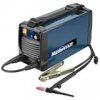Since MOT saturate due to
1) insufficient iron in the core
2) insufficient inductance limiting primary current
(This is due to consumer economics as copper = $$$ and Silicon Iron = weight.)
We have a lot of heating going on under no load. (A secondary load decreases primary flux density)
One can either create an adjustable air gap by separating the E laminations from the I. and shimming the gap with an insulator. Easily done by filing off the weld with a dremel and shimming with hardboard etc. OR increase the Primary inductance by adding an inductor of some magnitude in series with the Primary. Often a second MOT is used for this.
Increasing the Turns/Volt in the Primary will be tough, I think they need to be doubled.
Then there is reducing the voltage at the secondary, variac anyone?
It has occurred to me to use regular steel sheet cut to strip, lacquered and stack as laminates to create a box around the MOT in an effort to increase the saturation limit of the iron core. But that requires some time I don't have right now.
here is some useful info.
**broken link removed**
EDIT one last interesting option is to place a triac in front of the transformer and chop the incoming sinewave, thus increasing the frequency of the supply. This has the effect of increasing the inductive impedance effect of the existing Primary and thus reducing the Turns/Volt requirement. Perhaps it might be better to rectify the supply and create a pulsed DC supply kinda like a switch mode PSU, with consequent efficiency gains. Depends on your app. Due to the iron laminations u can't bump the freq too high, eddy currents will kill efficiency. Just go high enough to eliminate the heating energy loss, prob 120Hz would be good.
https://www.electro-tech-online.com/threads/inductor-transformer-size-vs-frequency.111880/





